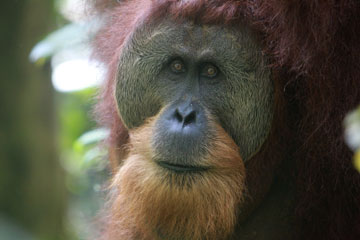Rehabilitation not enough to solve orangutan crisis in Indonesia
A baby orangutan ambles across the grass at the Borneo Orangutan Survival Foundation’s Nyaru Menteng rehabilitation center in Central Kalimantan, in the heart of Indonesian Borneo. The ape pauses, picks up a stick and makes his way over to a plastic log, lined with small holes. Breaking the stick in two, he pokes one end into a hole in an effort to extract honey that has been deposited by a conservation worker. His expression shows the tool’s use has been fruitful.
But he is not alone. To his right another orangutan has turned half a coconut shell into a helmet, two others wrestle on the lawn, and another youngster scales a papaya tree. There are dozens of orangutans, all of which are about the same age. Just outside the compound, dozens of younger orangutans are getting climbing lessons from the Borneo Orangutan Survival Foundation (BOS) staff, while still younger orangutans are being fed milk from bottles in a nearby nursery. Still more orangutans—teenagers and adults—can be found on “Orangutan Island” beyond the center’s main grounds. Meanwhile several recently wild orangutans sit in cages. This is a waiting game. BOS hopes to eventually release all of these orangutans back into their natural habitat—the majestic rainforests and swampy peatlands of Central Kalimantan, on the island of Borneo. But for many, this is a fate that may never be realized.
| |
| Kalimantan, 2009 |
 |
So the orangutans must wait. But they are the lucky ones. For every orangutan housed in the center, half a dozen or more may have fallen victim to deforestation or the pet trade, or met their end at the blade of a machete or the blunt end of a iron bar—estimates range from 1,500-5,000 per year. Perhaps worse, some reintroduced orangutans have managed to win taste of freedom only to see their new home destroyed by loggers and oil palm developers.
Orangutan rehabilitation centers originally emerged as a response to the pet trade. Until very recently in much of the world (and even today in parts of Asia and the Middle East), there has been demand for orangutans as circus performers, entertainers for TV shows, occupants of zoos, and surrogate children for childless families. Before much was known about orangutan ecology, the first rehabilitation center was set up in the1960s by conservationist Barbara Harrison, who feared the species might be on the verge of extinction in the wild due to overcollection for the pet trade. Thus centers—including Ketambe and Bohorok in Sumatra’s Gunung Leuser National Park; Sepilok in Sabah, Malaysia; Camp Leakey in Central Kalimantan’s Tanjung Putting National Park; Semenggok in Sarawak, Malaysia; and Wanariset in East Kalimantan, among others—emerged as a way to care for confiscated orangutans in the hope of eventually reintroducing them to the wild. But caring for orangutans is difficult and costly. While baby orangutans score high for their cuteness factor, an adult orangutan, especially a full-grown male, is orders of magnitude stronger than a human and has substantial dietary requirements.
 |
| |
But while the flow of orangutans from the pet trade was relatively manageable, the rise of palm oil has changed the situation, greatly increasing the number of orangutans in need of care. Michelle Desilets, former director of BOS-UK and now executive director of the Orangutan Land Trust, says she started to see the shift about five years ago.
"Originally the great majority of our rescues were confiscations of privately (illegally) owned orangutans. Often these were held by senior police officers, the military or government officials, making it a challenge to successfully confiscate them,” she said.
"About five years ago, our rescue teams began to be informed of wandering wild orangutans in human settlements, and despite immediate response, the teams often found the orangutans to be dead on arrival, due to human/wildlife conflict. Why, suddenly, were there so many cases of wild orangutans being injured or kill ed by humans? It had to do with the conversion of their forest habitat for the cultivation of oil palm.”

Desilets says the wild orangutans, left in ever smaller fragments of forest, face starvation as their food sources are depleted, forcing them to venture into newly established plantations where they feed on the young shoots of palms, thereby destroying the trees before they produce any oil seeds.
“As a result, they are considered an agricultural pest. Plantation managers often offer a bounty on the head of these orangutans, and the $10-$20 reward is a strong incentive for a migrant worker.”
Desilets says that since workers usually do not carry guns, orangutans are brutally killed using whatever tools are at hand.
“Our teams have found orangutans beaten to death with wooden planks and iron bars, butchered by machetes, beaten unconscious and buried alive, and doused with petrol and set alight,” she said. “Since 2004 more and more orangutans in our centers have been rescued from areas within or near oil palm plantations, and over 90 percent of the infants up to three years of age come from these areas."
Taken from:
mongabay.com
Source
No comments:
Post a Comment